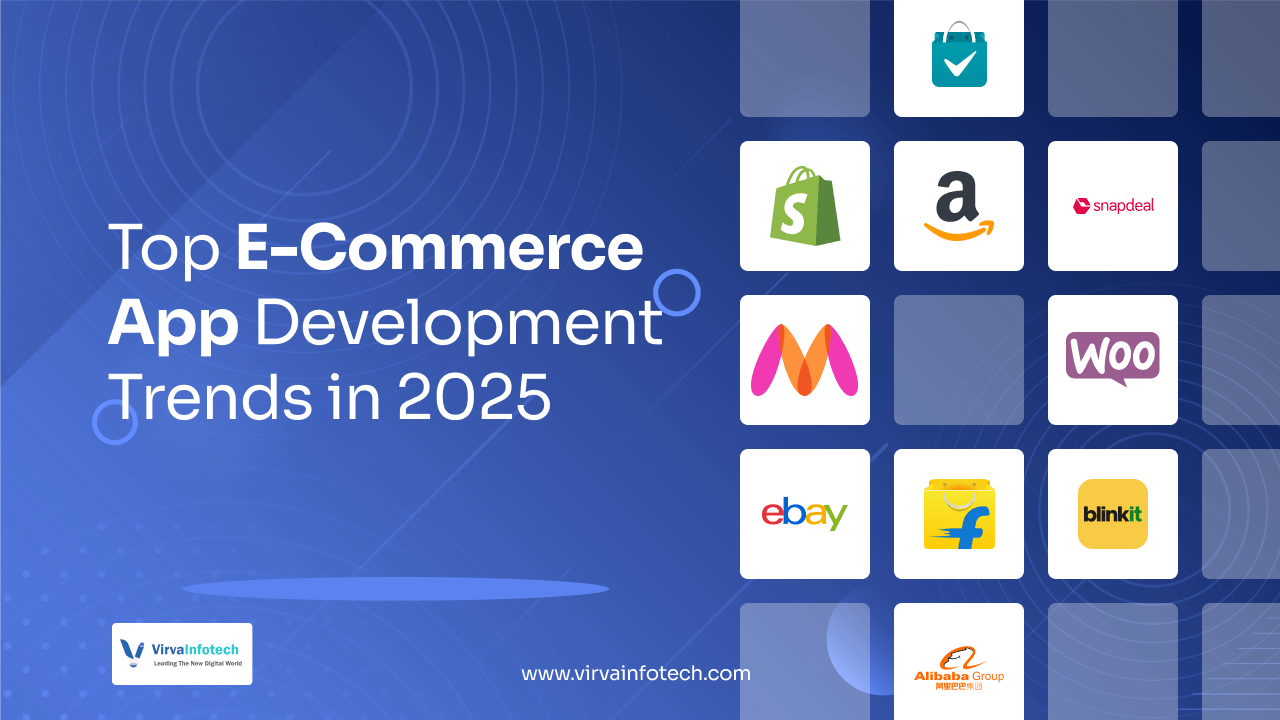Posted At: Feb 20, 2025 - 172 Views

Introduction
The e-commerce industry is evolving at a rapid pace, driven by technological advancements and changing consumer expectations. In 2025, businesses must adopt the latest e-commerce app development trends to stay competitive, improve user experience, and boost sales. From Artificial Intelligence (AI) & Machine Learning (ML) to Motion Design, these trends are shaping the future of online shopping. In this article, we’ll explore the top 10 e-commerce technology trends and how they can enhance your business.
For a Detailed Guide on building an E-commerce app, check out this article :
How to Build a Successful E-Commerce App
1. Artificial Intelligence (AI) & Machine Learning (ML) in E-Commerce
The integration of Artificial Intelligence (AI) in e-commerce apps is revolutionizing how businesses interact with customers by offering personalized shopping experiences, automating operations, and optimizing digital marketing campaigns.
For E-commerce sites, Machine Learning (ML) can be used to analyze user behaviour, and patterns of browsing and suggesting best-selling items based on users' personal interests. Businesses can improve conversion rates and enhance customer engagement by utilizing this data-driven strategy.
Also, chatbots and voice assistant systems are changing the way customers are supported, as they can provide faster responses, assist with FAQs or help users navigate the purchase process. Business owners can reduce operational expenses and enhance user satisfaction through the use of AI-driven automation tools.
Why are AI and ML crucial for the growth of online retailing?
✅Amazon-like AI suggestions for products.
✅Customer support automated through chatbots and virtual assistants.
✅Inventory and sales forecasting using predictive analytics.
✅Improved security measures and fraud detection.
2. Augmented Reality (AR) & Virtual Reality (VR) in E-Commerce
The integration of Augmented Reality (AR) and Virtual reality (VR), which enable customers to experience product visualization in real-life environments before making a purchase, is revolutionizing online shopping. By connecting consumers to both physical and digital shopping experiences, these technologies can enhance user engagement and boost buyer confidence.
The use of AR shopping apps allows users to experiment with virtual try-ons that include clothing, accessories, and makeup options at the touch of a button. By utilizing 3D product visualizations, customers can interact with products from any angle and view, which is particularly beneficial when shopping for furniture, home decor, or electronics.
Virtual showrooms can be accessed by customers through immersive shopping experiences powered by virtual reality, making online shopping more engaging. By incorporating VR technology in e-commerce development, businesses can achieve lower product return rates by providing buyers with a more accurate understanding of their purchase.
Why AR & VR Game-Changers in E-Commerce?
✅ Virtual Try-Ons – Let customers try before they buy (fashion, eyewear, beauty).
✅ 3D Product Visualization – Interactive product previews for furniture & gadgets.
✅ Immersive Shopping Experiences – Virtual stores & showrooms for better engagement.
✅ Reduced Return Rates – Fewer disappointments, leading to higher customer satisfaction.
3. AI-Powered Chatbots: Enhancing Customer Support in E-Commerce
Chatbots powered by artificial intelligence are taking over the customer experience in e-commerce, offering 24/7 support, order assistance and immediate responses. The ability of chatbots to address numerous inquiries simultaneously can lead to a significant decrease in customer wait times and an increase in overall user satisfaction.
Modern e-commerce chatbots use Machine Learning and Natural Language Processing (NLP) to understand customer intent, provide accurate responses for users, and suggest relevant products.
Furthermore, chatbots powered by artificial intelligence can be integrated with WhatsApp, Facebook Messenger, and online marketplaces, facilitating cross-functional communication. Some advanced chatbots offer voice-based assistance, which enhances the conversational shopping experience.
Why Are AI Chatbots Essential for E-Commerce?
✅ 24/7 Customer Support – Immediate assistance anytime, anywhere.
✅ Reduced Response Time – No more long waiting times for customer queries.
✅ Personalized Shopping Assistance – Product recommendations based on user behaviour.
✅ Multi-Channel Integration – Available on websites, social media, and messaging apps.
4. Mobile Wallets & Contactless Payments: The Future of E-Commerce Transactions
Fast, secure, and hassle-free transactions can be e-transactions by mobile wallets and contactless payment technology in e-commerce. That's the way customers expect their transactions today. High conversion rates are known for those businesses that can offer customers more than one mobile payment option.
Popular mobile wallets like Google Pay, Apple Pay, PayPal, and Samsung Pay allow users to complete transactions with just a tap, eliminating the need to manually enter payment details. This not only speeds up the checkout process but also enhances security through encrypted transactions and biometric authentication (fingerprint/face ID).
Additionally, contactless payment technology enables one-click checkout, which plays a crucial role in reducing cart abandonment rates. Studies show that long and complicated checkout processes are a major reason for customers abandoning their carts. By offering multiple digital payment solutions, businesses can ensure higher customer satisfaction and increased sales.
Why Mobile Wallets & Contactless Payments Are Essential for E-Commerce?
✅ Faster Transactions – Quick, seamless checkouts with one-tap payments
✅ Enhanced Security – Encrypted transactions with biometric authentication
✅ Reduced Cart Abandonment – No lengthy payment forms, leading to higher conversions
✅ Multi-Payment Options – Accept payments via Google Pay, Apple Pay, PayPal, and more
5. The Subscription Model is the primary method for retaining customers and earning repeat revenue
By offering convenience, exclusive products, and recurring deliveries, subscription-based e-commerce is becoming increasingly popular among businesses looking to generate consistent revenue. Users can expect to keep buying from this model for an extended period, as they are given weekly, monthly, or yearly access to their preferred products or services through subscriptions.
Customers have been influenced by online subscription platforms like Amazon Subscribe & Save, Birchbox, and Netflix, which have revolutionized the landscape of e-commerce subscriptions. By offering subscription boxes(for beauty, fitness, and food), digital streaming services, or software (SaaS) subscriptions, this model ensures a loyal customer base and consistent sales.
In addition, businesses operating in subscription-based e-commerce can benefit from personalized recommendations, loyalty discounts, and flexible payment methods, which are highly appealing. Along with enhancing customer lifetime value (CLV), this also results in a decrease in the cost of acquiring customers over time.
Why Subscription-Based E-Commerce is the Future?
✅ Recurring Revenue Stream – Predictable sales and financial stability.
✅ Higher Customer Retention – Subscribers stay engaged longer than one-time buyers.
✅ Convenience for Customers – Automated deliveries and hassle-free shopping.
✅ Exclusive Perks & Discounts – Members get access to special deals and early product launches.
6. E-Commerce Shopping on the Rise with Voice & Visual Search
Voice search is becoming more prevalent in e-commerce, leading to changes in how customers shop. Shoppers are now able to find products more quickly and efficiently with the help of voice-activated search tools like Alexa, Siri, or Google Assistant. With hands-free shopping, this technology enables users to browse, compare and order items with just their voice.
Simultaneously, e-commerce is making it possible for users to search for products using images uploaded by the user through visual search. Shoppers can use pictures of their preferred products and search for similar items online instead of manually typing keywords. Earlier this year, Google Lens, Pinterest Lens and Snapchat Scan were among the first companies to use AI-powered visual search for online shopping.
E-commerce businesses can enhance user experience through voice and visual search features, which can improve user engagement, reduce friction in searches (and make shopping more convenient and efficient), and increase conversion rates.
Why Are Voice & Visual Search Game-Changers in E-Commerce?
✅ Voice-Activated Shopping – Hands-free product search & ordering via Alexa, Siri, and Google Assistant.
✅ AI-powered visual Search – Find products instantly by uploading images instead of typing queries.
✅ Faster & More Intuitive Shopping – Reduces the time needed to find the right product.
✅ Higher Conversion Rates – Helps customers discover products with greater accuracy and ease.
7. Fast & Free Delivery: The Ultimate Game-Changer in E-Commerce
E-commerce has become increasingly competitive, and customers are more likely to be satisfied with fast and free delivery services. Consumers now expect their orders to be delivered quickly and for free, making same-day delivery and express shipping essential features for businesses operating online.
With one-day or two-week delivery, along with free shipping on eligible orders, companies such as Amazon.com, Walmart and Flipkart have surpassed their competition. By enhancing the shopping experience, these tactics result in reduced waiting times and increased repeat purchases.
A well-designed e-commerce logistics system and AI-driven order fulfillment ensure efficient, costless shipping of goods. The company is committed to this strategy. High delivery charges are a major factor in the cart abandonment rate, which is often caused by retailers offering fast and free shipping.
Why Fast & Free Delivery Matters in E-Commerce?
✅ Same-Day & Next-Day Delivery – Quick shipping improves customer satisfaction.
✅ Reduced Cart Abandonment – Free shipping increases checkout conversions.
✅ Competitive Advantage – Faster shipping attracts more loyal customers.
✅ Optimized Logistics & AI-Powered Fulfillment – Ensures cost-effective and efficient deliveries.
8. Flexible Payment Options: Enhancing Affordability & Customer Convenience
The increasing popularity of e-commerce has made it crucial to provide customers with flexible payment options, which can improve their experience and increase sales. The shopping public expects a range of payment methods, including credit/debit cards, UPI, digital wallets(Google Pay, Apple Pay and PayPal), and Buy Now, Pay Later (BNPL) services.
By dividing payments into installments, Klarna, Afterpay, and Affirm provide shoppers with the option to purchase items at lower prices and increase transaction sizes. Interest-free installment plans are the preferred choice among younger consumers who have embraced the BNPL model.
Customers can enjoy more financial freedom by opting for EMI, COD, and subscription-based payments during their shopping experience. When e-commerce brands adopt these options, they experience higher order values, decreased cart abandonment, and better customer engagement.
Why Are Flexible Payment Options Crucial for E-Commerce?
✅ Buy Now, Pay Later (BNPL) – Allows shoppers to split payments over time.
✅ Multiple Payment Methods – Supports UPI, PayPal, digital wallets, credit/debit cards, and EMI.
✅ Higher Conversion Rates – Customers are more likely to complete purchases with flexible payment plans.
✅ Reduced Cart Abandonment – Eliminates financial barriers, making expensive products more accessible.
9. Mobile Security: Protecting E-Commerce Transactions & Customer Data
As more people use mobile e-commerce apps, it is crucial to prioritize robust mobile security. To ensure the safety of consumers and online transactions from harmful cyber attacks, data breaches, and payment frauds, it is crucial to implement robust security measures.
Integrated end-to-end encryption is used in secure e-commerce payment systems to ensure the protection of sensitive financial data during transactions. Also, secure payment platforms like PayPal, Stripe, Razorpay and Apple Pay offer encrypted payment processing to lower the risk of fraudulent transactions.
Companies have started implementing two-factor authentication (2FA), biometric logins (fingerprint & face ID), and SSL encryption to protect user accounts. In addition to preventing unauthorized access, these features provide shoppers with increased confidence in shopping online, without any concerns about privacy.
Why Mobile Security Is Critical for E-Commerce?
✅ Secure Payment Gateways – Encrypted transactions through trusted processors like PayPal, Stripe, and Razorpay.
✅ Two-factor authentication (2FA) – This adds an extra layer of security for user accounts.
✅ End-to-End Encryption – Protects sensitive customer data from cyber threats.
✅ SSL Certificates & Fraud Detection – Ensures safe browsing and prevents identity theft.
10. Motion Design: Enhancing User Experience & Engagement in E-Commerce
In modern e-commerce apps, the use of motion design is key to improving UX and increasing customer engagement. Motion UI, subtle animations, and dynamic transitions contribute to the visual appeal, intuitiveness or interaction of mobile apps.
Users navigate through an e-commerce app with smooth page transitions, hover effects, micro-interactions and animated buttons. With Motion UI, users can concentrate on crucial sections like "Add to Cart," in-app purchases, and promotional materials by selecting from the options.
The shopping experience is made more enjoyable with the inclusion of dynamic productdisplays and interactive loading screens. Motion-based design is being used by brands like Amazon, Apple, and Nike to improve user experience and reduce bounce rates.
Why do Motion UI & Animations Matter in E-Commerce?
✅ Improved Navigation – Animated transitions provide a smooth and intuitive app experience.
✅ Higher Engagement – Micro-interactions & hover effects make browsing more interactive.
✅ Better Conversion Rates – Motion-based elements guide users toward quick purchasing decisions.
✅ Enhanced Customer Retention – Engaging UI keeps users coming back to the app.
Conclusion
As we enter 2025, adopting these e-commerce app development trends is essential for staying ahead in the competitive digital landscape. Whether it’s AI-driven personalization, secure mobile payments, or immersive AR shopping, businesses must evolve to meet consumer expectations. By leveraging these innovations, you can create a future-proof e-commerce app that enhances user engagement, boosts conversions, and ensures long-term success.
🚀 Stay ahead in the e-commerce industry by implementing these trends today!


